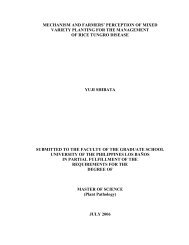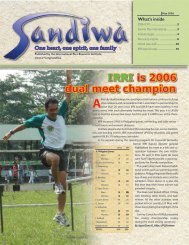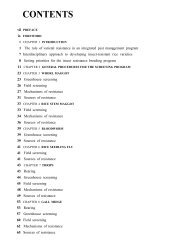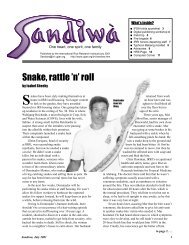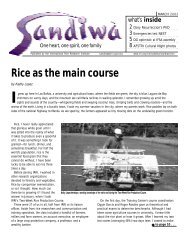Untitled - International Rice Research Institute
Untitled - International Rice Research Institute
Untitled - International Rice Research Institute
You also want an ePaper? Increase the reach of your titles
YUMPU automatically turns print PDFs into web optimized ePapers that Google loves.
which take into account various production situations<br />
and ecology. In reality, it is not possible or desirable<br />
to obtain seed lots free from any organism (Mew<br />
1997).<br />
From a plant pathologist’s point of view, there<br />
are missing links in documented information on<br />
seedborne pathogens. McGee (1995) pointed out the<br />
need for accurate information on seed transmission<br />
of some key seedborne pathogens. We need to study<br />
the epidemiology of seedborne pathogens in relation<br />
to disease development in the field. We need yield<br />
loss data to estimate the risk of seedborne pathogens.<br />
Furthermore, we need to study the role of seed health<br />
testing to improve farmers’ pest management and<br />
crop production. To know whether common pathogens<br />
carried by the seed pose a threat to crop production,<br />
we need to understand disease epidemiology.<br />
Conventional seed health testing provides adequate<br />
information about the frequency of detection from the<br />
seed and levels of seed infection. We need to assess<br />
whether these pathogens, upon detection, could be<br />
transmitted to the field when the seed is sown and if<br />
the disease that develops causes damage or injury to<br />
effect yield loss. In scientific literature, this information<br />
is not readily available or it needs to be confirmed.<br />
Very little research has been done in this<br />
area. Because of the increasing concern about<br />
seedborne pathogens, we need to understand their<br />
epidemiology. The initial inoculum is the key to understanding<br />
what causes an epidemic in a plant quarantine<br />
context. The threshold inoculum carried by a<br />
seed lot has to be defined in terms of its effect on<br />
transmission and disease establishment. Detection<br />
methods and the potential role of nonpathogenic microorganisms,<br />
especially those possessing biological<br />
control properties, must be studied and taken into<br />
account.<br />
2



